
Pre-baiting for carp is one of the most important tactics that you can use as a carp angler to consistently catch carp. Baiting properly is an acquired skill that can take time and experience to master.
Many amateur carp anglers fail to see the benefits of pre-baiting and often seem to think it is not worthwhile. This post is sure to debunk this idea and show you exactly how to pre-bait effectively and how you can improve your fishing sessions.
Let’s take a look at what you should look out for when baiting, and how you can bait effectively to catch more fish.
What Exactly is Pre-Baiting?
Pre-baiting is a method that is commonly used by experienced carp anglers to bring carp into a specific swim they plan to fish. By throwing lots of free food into these areas before or during your fishing sessions the carp will start to frequent this area looking for more freebies.
Guess what that means? Yep, chances are the fish are still going to check in to this area to see if there is any more free food when your hook bait is also in the spot.
By pre-baiting, without fishing tackle and hooks in the swim, the fish will start to become relaxed in this area and will commonly feed heavily in this specific area.
This method is without a doubt one of the top ways to improve your catch rate which can even see anglers traveling hours to pre-bait areas before their rods even leave the van.
You’ll learn everything you need to know about pre-baiting below to get you catching more fish in no time.
Picking the Right Swim
The first step to baiting effectively is to make sure your fishing an active carp area where they move through on a regular basis in search of food.
Other areas are travel areas that can work like a funnel or natural causeway for carp, they might not be in the specific area to hold and feed, but pass through on their way to areas that they do frequent for feeding. This is similar to hunting big game, you study the routes they travel to and from a food source.
High travel areas can be predictable in many cases, and can be the tips of land points, canals connecting two bodies of water, or slightly deeper channels running through thick submergent or emergent vegetation.
The best way to find active swims is to simply scout the water if you are unfamiliar with it, watch for signs of dirt clouds or fish breaking the surface, if you see these indicators on a regular basis in a specific area, chances are that you found an active swim.
Margins
The margins can be a great place to start when pre-baiting areas of a fishing water.
The margins are largely overlooked by the majority of anglers. Carp will spend a lot of time in the margins searching for natural food sources, taking cover in weeds or even looking for slightly warmer water.
Pre-baiting the margins also takes away the need for spods, spombs, pva bags and throwing accessories which can make the process a whole lot easier.
You can also be far more accurate if you’re throwing in handfuls of bait not far from the bank.
Light Weed
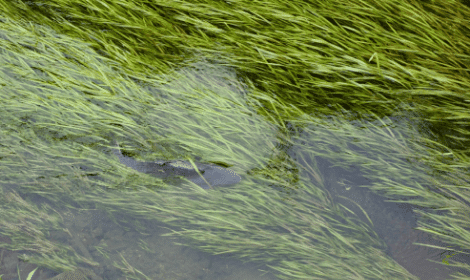
Areas of low and sparse weeds can be another great place to start. Carp love to spend time in weeds.
Weed contains plenty of natural food sources for carp, an area where they feel secure and protected and increased oxygen levels in daylight hours.
You can also be pretty sure that anglers on your waters have not pre-baited these areas.
When pre-baiting these areas the carp will naturally clear a clearing in the weeds as they root around the silt in search for the added bait.
This provides a perfect spot to fish when you arrive for your fishing session.
Carp Showing

Another great way to work out where you should be pre-baiting on new waters is to look for visual signs of carp across the water.
This can commonly be sightings of carp on certain areas jumping out of the water, rolling on the surface or carp “head and shouldering”.
If you manage to spot carp jumping out of the water or head and shouldering which is sort of a half jump this could indicate a great spot to bait.
These acts generally mean that the carp is trying to push silt and other debris from its gills after it has been feeding in silty areas of a water.
By baiting the locations below the jumping carp you have a good chance that the carp will be feeding here and continue to feed on your pre-bait.
Bait More than One Swim
After scouting the lake you may have found the perfect swim to bait, carp showing, features and a perfect clear bottom.
It can be very tempting to only bait this spot but you should really find another 2 to 3 spots that are worthy of some pre-bait.
By doing so you limit the chances of having a flop of a session when you return to fish your baited area.
What if you return and theirs another angler fishing your spot? or even there are now no carp in this area?
If you have chosen to bait this one swim your fishing session could turn into a complete disaster.
Pre-baiting Mix
The number of options for baiting in terms of specific flavourings seems to be endless in the carp fishing world. But there are also multiple different types of bait types to choose from, lets look at some of the most popular bait types and mixes.
Boilies
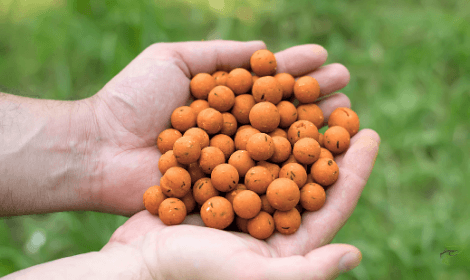
Boilies are one of the most popular out there for carp, and they can be made at home or bought at shops and can come in a variety of shapes and flavours.
Flavours include anything from a bloodworm mix to raspberry, pineapple, chicken, sour cream, you name it and you can probably find it.
Boilies can range from 10 to 24mm or even larger, but the most common size is generally in the 14 to 16mm range.
Boilies can also serve as impromptu particle or groundbaits by simply crushing them into smaller pieces instead of the round ball shapes. This is a great tip to use on the fly if you don’t have any of this bait while you’re on the water, and you can simply improvise.
Pellets
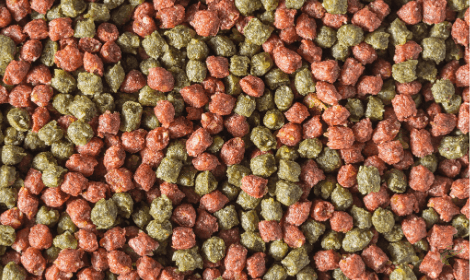
Pellets are similar to boilies when it comes to the unlimited flavour options, with the major difference being the size. Pellets are great for when you want to bait an area with more bait but with smaller offerings, as small baits like pellets are more prone to spread a little more and blanket a small area.
Pellets are great when using PVA bags as your bait delivery system, but can work well with spombs and spods as well.
Groundbait
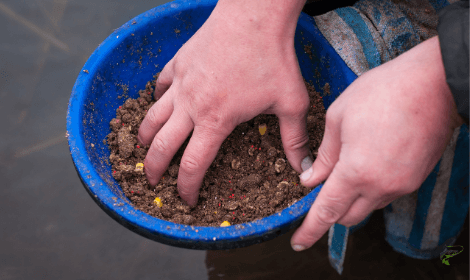
Groundbait is a bit of a different offering in some ways. Groundbait is more of a paste with a consistency similar to that of coarse dirt or sand. It can also come in a variety of food such as corn, fishmeal, bloodworms, or a combination of several things.
Groundbait works great with slingshots but might be a little trickier with spods and spombs.
For spods this is due to the tendency for it to escape the spod openings if it’s too dry and not packed tightly in spods.
For spombs it can get into the spaces of the release mechanism, clog it and cause opening failures when contacting the water. It’s also simply put messier.
They also will most likely break apart and dissolve either when the balls hit the water, or shortly after soaking.
But despite some of its draw backs, This delivers a ton of scent into the water and the clouds can attract fish, and at times can be an incredibly effective attractor for hungry carp in the area.
Don’t be afraid to try the classics like corn, another great bait is meat, small cubes of chicken, beef, or the like can be killer for carp at times, so if you have any leftovers or freezer burnt meat, thaw it out, cut it up and throw it in a PVA bag or spod.
Bottom Composition
The bottom composition can be an important thing to consider when it comes to baiting a swim. Silty, bottoms with a high level of debris or mucky bottoms can present an issue in the form of covering up bait or letting it sink into the silt or muck.
It’s also important to note that carp don’t typically feed in these types of areas as much as they do in areas with clean and hard bottoms such as sand or clay, so your not as likely to be fishing in these areas to begin with, but they can still be productive at times. If you choose to bait the detritus it can actually add in holding carp, simply because they have to work through it to get your bait offerings, holding them near your hooked bait longer.
Spodding and Spombing
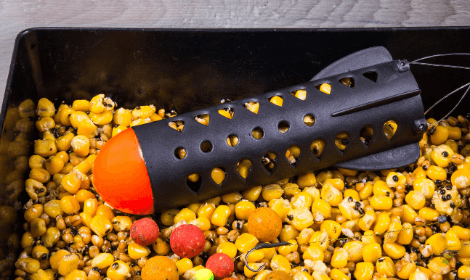
Spodding and spombing perform the same task, delivering sizable quantities of bait to a specific target.
Spods are open-ended with the open end facing up with smaller holes along the length and small fins to guide it. While spombs look like an old world war 2 style bomb with fins and a button at the nose which when thrown releases a spring hinge to open and release the carp bait.
The accuracy of these delivery devices, when cast out at distance, is totally dependent on your casting precision and if cast correctly can deliver, One tip to help with getting the correct distance to your preferred area for baiting is to use a marker rod to ensure accurate placement of every spomb or spod
cast. This can be tough depending on distance and wind, but with practice, you can keep all of your baiting casts in a 12×12 foot square.
PVA Bags
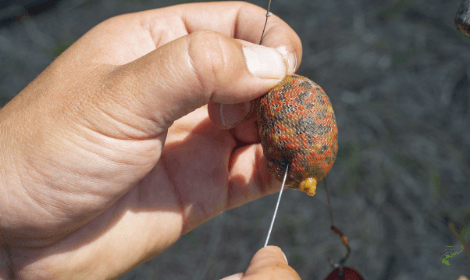
PVA bags are eco-friendly water-soluble plastic bags that dissolve in the water after a short period. They are great for baiting due to their ability to keep the bait amounts low.
They are also great in the fact that you can place your hooked rig with bait directly into the PVA bag and then tie the open end, so when you throw the PVA bag and it dissolves, the bait is in a nice small pile with your hook directly in the middle of the pile, or if you’re running a pop-up directly above it to entice a bite.
Out of all the baiting options, the PVA bag is definitely a popular one for me, it’s easy to use, has just the right amount of bait for a shorter session, and puts your hook in the perfect spot in relation to the free offerings.
PVA bags also come in a mesh form, the mesh forms will dissolve very fast and work great for large boilies.
PVA bags can work great for particles and the finer groundbaits but doing the same thing that boilies and pellets benefit from them, keeping them in a small localized pile or area.
Throwing Sticks or Catapults
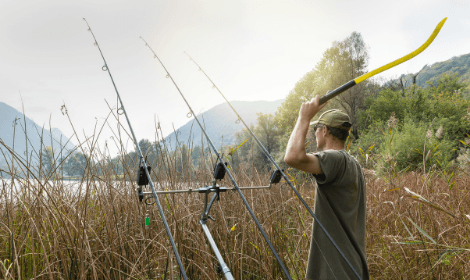
It is also fairly common to see anglers using throwing sticks and catapults to bait up swims that aren’t too unreachable.
If you are looking for an extremely accurate and tight bunch of bait on the bottom then you’re probably best to stick to PVA bags, spodding or spombing.
Throwing sticks will provide a nice spread of single baits such as boilies, large pellets or even tiger nuts but they pretty useless if you’re baiting with ground bait or other sticky mixes.
Catapults on the other hand will work for both balls of stickier mixes and also single baits like boilies and large pellets.
Although these method might seem straight forward you’ll need a lot of practice to really hone your skills in for accuracy.
How Much, How often?
You might get different answers depending on who you ask when it comes to the topics of how much bait you should put out in a session and how frequently you should rebait.
The general rule of thumb is to keep your pre-baiting or re-baiting of a swim to a minimum in terms of the amount used. The simple reason for this is because you don’t want to give the Carp swimming in the area a free buffet, but rather, get their attention and give them an enticing snack until they grab the wrong pineapple boilie with a hook attached to it.
Overbaiting a swim can ruin your entire session by feeding the carp with free bait while not catching any.
With the small amount portion laid out, you should bait fairly frequently, potentially after a catch as the carp you just caught may have eaten most of the previous small offering, so after catches is a great time.
If your fishing an area and haven’t caught any fish, it might be a good idea to re-bait every 2 hours or so. The bait will slowly dissolve or break up underwater and disintegrate, so it’s a good idea to refresh your swim every 2-3 hours.
One good tip to follow is to bait even less in the cold weather months like late autumn and winter. All fish have slower metabolisms at this time with carp not being an exception. Due to the slower metabolism, carp feed less, and thus your free bait offerings should be minimal.
That’s All!
Pre-baiting for carp is something that you as a carp angler should not overlook and doing it improperly can be detrimental to catching fish by over baiting or by inaccurate placement.
Take the time to bait precisely in a given session in areas where there is high traffic and you will reap the rewards.

